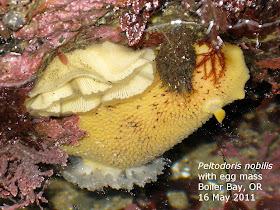It’s time to home in on the extreme low tides we get in our local marine environment during daylight hours in the summer. Get to the coast an hour before the low and spend a couple of hours looking in the shallow water and especially in pools left by the receding tide. If the pool is rich enough, just sit down and enjoy watching the invertebrates and fish, if there are any, go about their business.
But don't think you have to shed your clothes; the nudity here involves the animals you are watching. Among the animals that inhabit such places are the nudibranchs (= naked gills). These are mollusks that appear to lack shells, something like seagoing slugs; many have prominent external gills. Like slugs, they are members of the class Gastropoda, which includes the snails. Having dispensed with a shell gives the nudibranchs both constraints and opportunities.
The primary constraint, of course, would seem to be a much greater risk of predation without a hard shell into which to retire when disturbed. Along with this is the risk of desiccation when exposed at low tides, so you won’t find many nudibranchs sitting around on exposed rocks like you do some of the snails.
These are mostly small animals, ranging from 1 cm (Rostanga) up to 20 cm (Peltodoris), but because of their conspicuousness and beauty, they are more admired and sought by tidepoolers than some of the other invertebrates that share their habitat.
Prominent anatomical features are two tentacle-like structures toward the front that are called rhizophores and are probably chemical detectors. Toward the rear there may be a ring of gills. And projections all along the upper surface are cerata, the bright colors of which are probably involved in predator deterrence, a warning coloration that goes along with distastefulness.
The lack of a shell has provided selective pressure for nudibranchs to develop other ways of protecting themselves from predators, and one of the most effective is the ability to secrete chemicals, including sulfuric acid in some cases, that make them inedible. They are surprisingly predator-free, and fish have been seen to spit them out. Anything as conspicuous as some of these are would seem to be predator resistant!
One of the opportunities for such animals comes in the form of being free to be predators themselves. They often specialize in animals that aren’t eaten by many other predators, thus assuring them a reliable food supply. Most of their prey items are sessile, fixed to the rocks on which they crawl, but a few are able to capture motile animals as well.
Acanthodoris eats colonial ascidians (tunicates) and bryozoans. Triopha and Janolus eat arborescent (branched) bryozoans. Doris and Peltodoris eat sponges, especially the crumb-of-bread sponge (Halichondra), and how they avoid being pierced by the sponge spicules hasn’t been determined. These two species are called sea lemons. The tiny Rostanga eats red sponges, on which it may be perfectly camouflaged. Hermissenda eats hydroids and incorporates their toxic nematocysts into its cerata, thus affording it protection from predators. Dirona eats everything, including not only the same prey as the others but also snails and crustaceans.
The species shown here were found at two localities on the north coast of Oregon in May. All are common in Pacific Northwest waters.
Dennis Paulson












